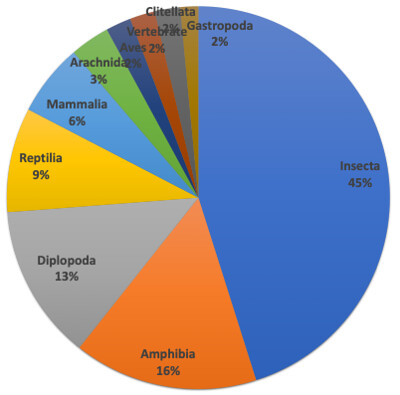Other roadkill on Lexington Reservoir summary
This journal post is an addition to Anne's post about the newt season summary - https://www.inaturalist.org/projects/pacific-newts-all-lexington-reservoir-area/journal/38733-2019-2020-newt-migration-season-summary
361 observations of 67 species of other roadkills along the Alma Bridge Rd. were documented by @truthseqr, @merav, @newtpatrol, @sea-kangaroo, @anudibranchmom, and @biohexx1.
For a presentation I did recently, I've decided to create a couple of figures using the other roadkill data collected as part of the Lexington newt study.
I think looking at the first figure, although it's not very informative, as you cannot see the details, it's amazing to see just how many newts die on the road each year, compared with all other animals combined.
 After removing over 10,000 newts (second figure), you can see the other groups represented more clearly.
After removing over 10,000 newts (second figure), you can see the other groups represented more clearly.
 The largest group is insects, with beetles and hymenopterans (bees and ants) being the most common organisms. There were some interesting seasonal patterns, some organisms were very common during the end of the winter, disappeared later, and were replaced by others. In the winter there were many earthworms, beetles and Jerusalem crickets, for example, and also large millipedes. They were all gone later, and replaced by bees and ants, and many other insects. In addition, in the winter there were many reptiles and other amphibians. Most snakes were found in January and February. Among the other amphibians, we documented frogs and toads, Arboreal Salamanders, Slender Salamanders, and even an Ensatina. Often we were unable to identify them to species.
Here's the actual data - for 2 seasons, 2018-2019 and 2019-2020 -
Newts 10145
Insecta 148
Amphibia 51
Diplopoda 43
Reptilia 29
Mammalia 20
Arachnida 11
Aves 7
Clitellata 7
Vertebrate 7
Gastropoda 5
Chilopoda 2
Actinopterygii 1
Arthropod 1
Broken into smaller groups -
Amphibians:
American Bullfrog 5
California Toad 3
Frogs and Toads 2
Sierran Tree Frog 4
Typical Frogs 1
Western Toad 23
Arboreal Salamander 5
California Slender Salamander 2
Ensatinas 1
Salamanders 1
Amphibians 4
Reptiles:
Aquatic Garter Snake 2
Coast Range Fence Lizard 3
Colubrid Snakes 1
Garter Snakes 4
Ringneck Snake 2
Santa Cruz Aquatic Garter Snake 2
Sharp-tailed Snake 2
Snakes 1
Southern Alligator Lizard 1
Western Alligator Lizards 1
Western Fence Lizard 8
Western Skink 1
Western Whiptail 1
Mammals:
Deer 4
Broad-footed Mole 5
California Mouse 1
California Pocket Mouse 1
California Vole 1
Eastern Gray Squirrel 1
North American Deer Mice 1
Rodents 2
Western Gray Squirrel 3
Arthropods:
Arachnida -
Araneae 6
Opiliones 3
Scorpiones 2
Chilopoda 2
Diplopoda 43
Spirobolida 7
Insects -
Coleoptera 46
Diptera 6
Hemiptera 4
Hymenoptera 35
Lepidoptera 23
Orthoptera 34
The largest group is insects, with beetles and hymenopterans (bees and ants) being the most common organisms. There were some interesting seasonal patterns, some organisms were very common during the end of the winter, disappeared later, and were replaced by others. In the winter there were many earthworms, beetles and Jerusalem crickets, for example, and also large millipedes. They were all gone later, and replaced by bees and ants, and many other insects. In addition, in the winter there were many reptiles and other amphibians. Most snakes were found in January and February. Among the other amphibians, we documented frogs and toads, Arboreal Salamanders, Slender Salamanders, and even an Ensatina. Often we were unable to identify them to species.
Here's the actual data - for 2 seasons, 2018-2019 and 2019-2020 -
Newts 10145
Insecta 148
Amphibia 51
Diplopoda 43
Reptilia 29
Mammalia 20
Arachnida 11
Aves 7
Clitellata 7
Vertebrate 7
Gastropoda 5
Chilopoda 2
Actinopterygii 1
Arthropod 1
Broken into smaller groups -
Amphibians:
American Bullfrog 5
California Toad 3
Frogs and Toads 2
Sierran Tree Frog 4
Typical Frogs 1
Western Toad 23
Arboreal Salamander 5
California Slender Salamander 2
Ensatinas 1
Salamanders 1
Amphibians 4
Reptiles:
Aquatic Garter Snake 2
Coast Range Fence Lizard 3
Colubrid Snakes 1
Garter Snakes 4
Ringneck Snake 2
Santa Cruz Aquatic Garter Snake 2
Sharp-tailed Snake 2
Snakes 1
Southern Alligator Lizard 1
Western Alligator Lizards 1
Western Fence Lizard 8
Western Skink 1
Western Whiptail 1
Mammals:
Deer 4
Broad-footed Mole 5
California Mouse 1
California Pocket Mouse 1
California Vole 1
Eastern Gray Squirrel 1
North American Deer Mice 1
Rodents 2
Western Gray Squirrel 3
Arthropods:
Arachnida -
Araneae 6
Opiliones 3
Scorpiones 2
Chilopoda 2
Diplopoda 43
Spirobolida 7
Insects -
Coleoptera 46
Diptera 6
Hemiptera 4
Hymenoptera 35
Lepidoptera 23
Orthoptera 34
Posted on
July 28, 2020 08:39 PM
by
 merav
merav
 After removing over 10,000 newts (second figure), you can see the other groups represented more clearly.
After removing over 10,000 newts (second figure), you can see the other groups represented more clearly.
 The largest group is insects, with beetles and hymenopterans (bees and ants) being the most common organisms. There were some interesting seasonal patterns, some organisms were very common during the end of the winter, disappeared later, and were replaced by others. In the winter there were many earthworms, beetles and Jerusalem crickets, for example, and also large millipedes. They were all gone later, and replaced by bees and ants, and many other insects. In addition, in the winter there were many reptiles and other amphibians. Most snakes were found in January and February. Among the other amphibians, we documented frogs and toads, Arboreal Salamanders, Slender Salamanders, and even an Ensatina. Often we were unable to identify them to species.
Here's the actual data - for 2 seasons, 2018-2019 and 2019-2020 -
Newts 10145
Insecta 148
Amphibia 51
Diplopoda 43
Reptilia 29
Mammalia 20
Arachnida 11
Aves 7
Clitellata 7
Vertebrate 7
Gastropoda 5
Chilopoda 2
Actinopterygii 1
Arthropod 1
Broken into smaller groups -
Amphibians:
American Bullfrog 5
California Toad 3
Frogs and Toads 2
Sierran Tree Frog 4
Typical Frogs 1
Western Toad 23
Arboreal Salamander 5
California Slender Salamander 2
Ensatinas 1
Salamanders 1
Amphibians 4
Reptiles:
Aquatic Garter Snake 2
Coast Range Fence Lizard 3
Colubrid Snakes 1
Garter Snakes 4
Ringneck Snake 2
Santa Cruz Aquatic Garter Snake 2
Sharp-tailed Snake 2
Snakes 1
Southern Alligator Lizard 1
Western Alligator Lizards 1
Western Fence Lizard 8
Western Skink 1
Western Whiptail 1
Mammals:
Deer 4
Broad-footed Mole 5
California Mouse 1
California Pocket Mouse 1
California Vole 1
Eastern Gray Squirrel 1
North American Deer Mice 1
Rodents 2
Western Gray Squirrel 3
Arthropods:
Arachnida -
Araneae 6
Opiliones 3
Scorpiones 2
Chilopoda 2
Diplopoda 43
Spirobolida 7
Insects -
Coleoptera 46
Diptera 6
Hemiptera 4
Hymenoptera 35
Lepidoptera 23
Orthoptera 34
The largest group is insects, with beetles and hymenopterans (bees and ants) being the most common organisms. There were some interesting seasonal patterns, some organisms were very common during the end of the winter, disappeared later, and were replaced by others. In the winter there were many earthworms, beetles and Jerusalem crickets, for example, and also large millipedes. They were all gone later, and replaced by bees and ants, and many other insects. In addition, in the winter there were many reptiles and other amphibians. Most snakes were found in January and February. Among the other amphibians, we documented frogs and toads, Arboreal Salamanders, Slender Salamanders, and even an Ensatina. Often we were unable to identify them to species.
Here's the actual data - for 2 seasons, 2018-2019 and 2019-2020 -
Newts 10145
Insecta 148
Amphibia 51
Diplopoda 43
Reptilia 29
Mammalia 20
Arachnida 11
Aves 7
Clitellata 7
Vertebrate 7
Gastropoda 5
Chilopoda 2
Actinopterygii 1
Arthropod 1
Broken into smaller groups -
Amphibians:
American Bullfrog 5
California Toad 3
Frogs and Toads 2
Sierran Tree Frog 4
Typical Frogs 1
Western Toad 23
Arboreal Salamander 5
California Slender Salamander 2
Ensatinas 1
Salamanders 1
Amphibians 4
Reptiles:
Aquatic Garter Snake 2
Coast Range Fence Lizard 3
Colubrid Snakes 1
Garter Snakes 4
Ringneck Snake 2
Santa Cruz Aquatic Garter Snake 2
Sharp-tailed Snake 2
Snakes 1
Southern Alligator Lizard 1
Western Alligator Lizards 1
Western Fence Lizard 8
Western Skink 1
Western Whiptail 1
Mammals:
Deer 4
Broad-footed Mole 5
California Mouse 1
California Pocket Mouse 1
California Vole 1
Eastern Gray Squirrel 1
North American Deer Mice 1
Rodents 2
Western Gray Squirrel 3
Arthropods:
Arachnida -
Araneae 6
Opiliones 3
Scorpiones 2
Chilopoda 2
Diplopoda 43
Spirobolida 7
Insects -
Coleoptera 46
Diptera 6
Hemiptera 4
Hymenoptera 35
Lepidoptera 23
Orthoptera 34





Comments
Anecdotally, I've noticed that in open space preserves and national wildlife refuges that allow mountain-biking, beetles and reptiles (mainly lizards) are taking a huge hit. I'm in SoCal, so usually pretty dry, otherwise amphibians would be up there too.
I agree! On many hiking trails I see "roadkill" insects and lizards too. Although it's often difficult to tell the cause of death, I think many are killed by bikes. I've created a project for dead arthropods to try and document that - https://www.inaturalist.org/projects/dead-arthropods-4f310cfa-27a3-4501-8244-512512ad568b
Very interesting analysis, @merav. It's stunning and sobering how much life is snuffed out by humans and their vehicles. Most people traveling along that road are probably oblivious to how much death follows in their wake. (I know I was oblivious before I saw the first few dead newts on the road and started paying attention.)
Add a Comment